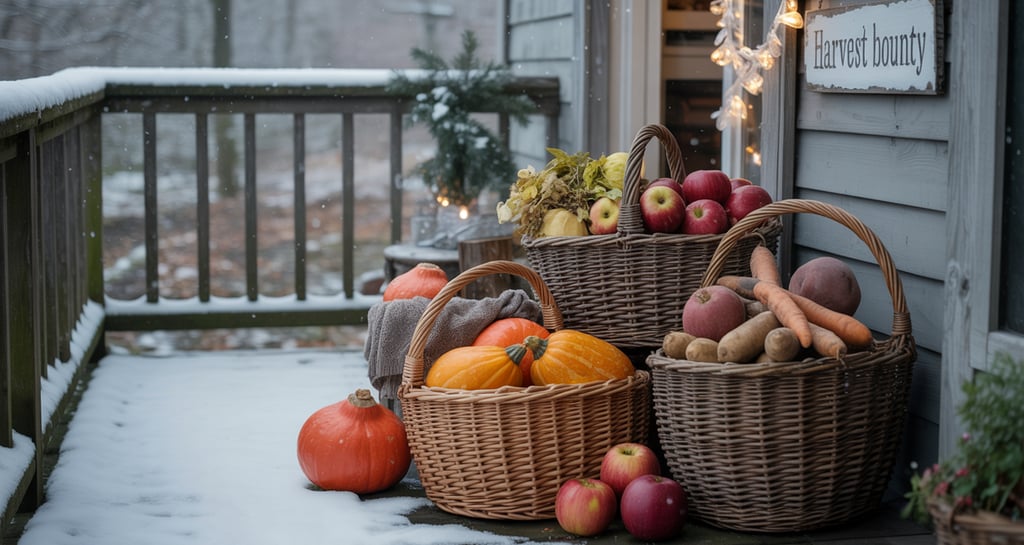Storing Food Without Refrigerator During the Winter
In today’s modern kitchen, refrigeration is a given. It has revolutionized food storage, extended shelf life, and reduced foodborne illnesses significantly. But what if you find yourself without refrigeration during the winter? Perhaps you live in a rural location without constant power, want to reduce energy consumption, or simply enjoy traditional, natural food preservation methods. Fortunately, winter naturally offers a cold environment that can act as a natural refrigerator, allowing safe food storage without electrical appliances if done properly. This comprehensive guide explores best practices, techniques, and safety tips for storing food during the winter months without a refrigerator to keep your food fresh, nutritious, and safe.
10/2/20254 min read


Why Store Food Without a Refrigerator?
While refrigeration technology is widespread, several reasons might lead you to store food without a fridge during winter:
Power outages or limited electricity access: Winter storms can cause blackouts, and some rural or off-grid homes may not have reliable electricity.
Energy saving or eco-friendly lifestyles: Some people prefer reducing dependency on electricity and embrace natural preservation methods.
Traditional or cultural practices: Many cultures have used natural cold storage methods successfully for centuries.
Emergency preparedness: In emergency kits or survival situations, knowing how to preserve food safely without refrigeration is invaluable.
Understanding natural winter food storage allows you to be prepared, save energy, and even impart natural flavours to your food through traditional methods.
How Cold is Cold Enough?
Before diving into storage methods, it’s critical to understand the cold temperatures required to keep food safe:
The U.S. Food and Drug Administration (FDA) recommends refrigerating perishable foods at or below 4°C (40°F).
Freezing occurs at 0°C (32°F).
In winter outdoor storage, temperatures typically fluctuate between freezing and just above, depending on your location and conditions.
Natural cold storage mimics refrigeration by keeping food in an environment as close as possible to these safe temperatures, ideally between 0°C and 4°C, to slow bacterial growth and enzymatic activity that cause spoilage.
What Foods Can Be Safely Stored Outside in Winter?
Not all foods are suited for natural cold storage outdoors. Here’s a list of common winter foods that can be stored safely without refrigeration when kept in a suitable environment:
1. Root Vegetables
Potatoes
Carrots
Beets
Turnips
Parsnips
Rutabagas
These vegetables have a long shelf life and thrive in cool, dark, and slightly humid environments. The winter cold preserves their texture and flavours well without significant spoilage.
2. Winter Squash and Pumpkins
Butternut, acorn, spaghetti squash, and pumpkins all store well for several months when kept cool and dry.
3. Apples and Pears
Hardy apples and pears harvested in the fall can be kept outdoors in cold conditions, ideally in ventilated, dry containers to prevent mould growth.
4. Cabbage and Other Hardy Greens
Cabbage heads, Brussels sprouts, and kale can tolerate cold weather and remain fresh if protected from frost and excess moisture.
5. Fermented Foods
Sauerkraut, kimchi, pickles, and other fermented vegetables naturally preserve themselves and can be stored as winter staples without refrigeration.
6. Cured and Smoked Meats
Salt-curing, smoking, and drying meats are traditional preservation methods for winter storage. These meats must be stored in cool, dry, and well-ventilated areas.
7. Hard Cheeses
Some aged cheeses can be stored safely in cool spaces slightly above freezing when sealed properly.
Safe Outdoor Storage Techniques
In colder climates, simply placing foods outside is not enough. Proper techniques must be employed to protect the food from pests, moisture, and temperature fluctuations:
1. Root Cellar or Cold Storage Box
A root cellar is a specially designed underground or partially underground room that maintains stable temperatures between 0°C and 4°C.
For outdoor storage without formal root cellar access, insulated cold boxes or bins can be fashioned and placed in shaded, sheltered areas.
Line storage boxes with straw or clean leaves to help regulate moisture and cushion the vegetables.
2. Ventilation and Drainage
Good airflow prevents mould and rot.
Ensure any storage containers have ventilation holes but are sheltered enough to avoid direct rain or snow.
Avoid placing foods directly on the ground; use pallets or boards for airflow and drainage to prevent freezing from moisture.
3. Wrapping and Packing
Wrap sensitive produce like apples lightly in paper to reduce moisture loss and prevent bruising.
Store root vegetables loose or in perforated bags to avoid trapping humidity that can cause rotting.
Check stored foods regularly for signs of spoilage, removing damaged items immediately.
4. Protection from Freezing and Thaw Cycles
Sudden freezing and thawing can damage produce. If temperatures fall below freezing, insulate storage boxes with blankets or straw layers.
If possible, keep storage areas in sheltered spots with indirect sunlight to avoid rapid temperature changes.
5. Use of Natural Indicators
Thermometers placed inside storage containers help monitor temperature.
Observe your food regularly for unexpected changes in texture or smell.
Indoor Cold Storage Options Without a Refrigerator
If outdoor storage is impractical, indoor cold storage strategies can be utilized:
1. Basement or Cellar
Underground or basement areas generally maintain cooler temperatures during winter.
Keep food stored away from direct heat sources.
2. Cool Pantry or Unheated Room
A room with an exterior wall exposed to cold air or a window that vents cool air can keep perishables fresh when combined with insulated storage containers.
Food Safety Guidelines for Storing Without Refrigeration
While winter temperatures can help preserve food, bacteria and moulds still pose risks if storage is neglected. Follow these guidelines for safety:
Do not store perishable dairy products, cooked leftovers, or fresh meats outside unless your storage area remains consistently below 4°C.
Avoid exposing food directly to sunlight or rain.
Do not consume food with off odours, slimy textures, discoloration, or visible mold.
Use food within safe storage periods; root vegetables usually last 2-4 months, apples 1-3 months, cured meats 2-6 weeks depending on conditions.
Regularly inspect your storage setup and rotate foods.
Traditional Winter Food Preservation Techniques That Complement Cold Storage
Combining cold storage with traditional methods can greatly extend food shelf life:
Salt Curing and Smoking Meats
Salt draws moisture out of meat, inhibiting bacterial growth. Smoking adds flavor and further preserves meat.
Fermentation
Pickling and fermenting vegetables creates a natural acidic environment where pathogens cannot thrive.
Drying
Dehydrating fruits, herbs, and meats preserves nutrients and prevents spoilage while reducing volume.
Tips for Winter Meal Planning Using Cold-Stored Foods
Plan recipes around your available fresh winter produce such as root vegetables and hardy greens.
Incorporate fermented foods to boost nutrition and digestion.
Use cured or smoked meats sparingly as flavourful protein sources.
Maintain proper hygiene and preparation techniques to avoid cross-contamination during cooking.
Storing food without a refrigerator during winter is entirely feasible with the right knowledge and preparation. By leveraging natural cold temperatures, traditional preservation techniques, and safe storage practices, it’s possible to maintain a healthy and varied diet even without modern refrigeration.
Whether you face temporary power loss, prefer sustainable living, or simply enjoy traditional methods, winter offers a unique opportunity to connect with timeless food preservation wisdom. Embrace these tips and techniques to keep your food fresh, flavourful, and safe through the colder months.
Join us on Pinterest
letstalk@lorybs.com
© 2025. All rights reserved.
